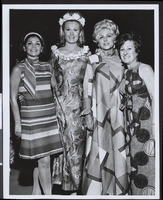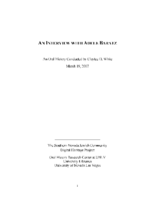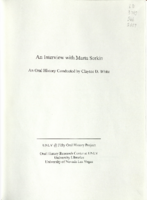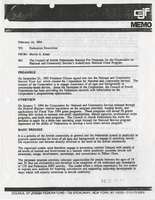Search the Special Collections and Archives Portal
Search Results

Hillel Jewish Student Center at UNLV
Hillel at the University of Nevada, Las Vegas (UNLV) was founded in 1976 by Roberta Sabbath. Jewish Federation director Jerry Countess encouraged Sabbath to start a Hillel group and provided funding of $3,000 for the first year. Hillel is a national organization that engages Jewish students on university campuses and encourages them to stay involved in Judaism. It provides activities, a way for Jewish students to network, and an on-campus Jewish community. Hillel's programming includes social and holiday events, educational speakers, and Shabbat services and dinners.
Corporate Body
Irwin Kishner oral history interview
Identifier
Abstract
Oral history interview with Irwin Kishner conducted by Claytee D. White on September 10, 2013 for the Southern Nevada Jewish Heritage Project. Kishner briefly discusses growing up Jewish in Brighton Beach area of Brooklyn, New York. He then discusses his family’s move to Miami, Florida and his relocation to Las Vegas, Nevada to work with his uncles, Herman and Maury Kishner. Other topics discussed include real estate management, and hotel operations in Nevada.
Archival Collection

Rabbi Sanford Akselrad oral history interview: transcript
Date
Archival Collection
Description
Oral history interview with Rabbi Sanford Akselrad conducted by Barbara Tabach on March 7, 2018 for the Remembering 1 October Oral History Project. In this interview, Rabbi Sanford Akselrad discusses the response of the Jewish community of Congregation Ner Tamid to the October 2017 mass shooting in Las Vegas, Nevada. He discusses the healing service he led the day after the shooting, how the community paid respect to the victims, and the concert held to raise money. In addition to the actions of the Jewish community, Rabbi Akselrad discusses the congregation's work with the interfaith community to heal from this tragedy.
Text
Gilbert Yarchever and Edythe Katz Yarchever oral history interview
Identifier
Abstract
Oral history interview with Gilbert and Edythe Katz Yarchever conducted on February 13, 2006 by Michael Geeser for the I Remember When: Recollections from Jewish Las Vegas Leaders Oral History Project sponsored by the Congregation Ner Tamid and the Las Vegas, Nevada Centennial Committee. In this interview, the Yarchevers talk about their roles in World War II and their involvement in the early history of Jewish temples in Las Vegas, Nevada. Edythe discusses her first husband's work on desegregation and her efforts in Holocaust education.
Archival Collection

Biographical essay by Perry Oehlbaum, 2014
Date
Archival Collection
Description
Perry Oehlbaum describes her time in concentration camps in Germany and her liberation in 1945.
Text

Scrapbook pages from the Las Vegas Chapter of Hadassah, 1968-1969
Date
Archival Collection
Description
This folder contains loose scrapbook pages documenting the years 1968 and 1969 for the Las Vegas Chapter of Hadassah. The pages hold photographs, pamphlets, invitations, newspaper clippings and other ephemera about the active chapter.
Mixed Content

Transcript of interview with Adele Baratz by Claytee D. White, March 19, 2007
Date
Archival Collection
Description
Interview with Adele Baratz by Claytee White on March 19, 2007. In this interview, Baratz talks about her parents who came to the United States as teenagers from Russia and eventually settled in Las Vegas after a short time in California. She discusses the Jewish community in Las Vegas when she was growing up, and her father's job selling bootlegging supplies, then as a real estate broker, then as a bar owner. Baratz attended the Fifth Street Grammar School, which was built after a fire destroyed the original school, and Las Vegas High School. As a teenager, she worked at Nellis as a messenger and in the rations department, then went to nursing school in Baltimore at Sinai Hospital. She talks about her father's bar, "Al's Bar," that was popular with Union Pacific Railroad workers, and how the bar was forced out for the building of the Golden Nugget. Baratz recounts where her family lived, the growth of the Jewish community, and building the first synagogue on Carson Street.
Text

Transcript of interview with Marta Sorkin by Claytee White, March 2, 2009
Date
Archival Collection
Description
In this interview, conducted for the 50th anniversary of UNLV, Marta Sorkin discusses her family and her experience moving to California, and then to Las Vegas. Sorkin worked at the James R. Dickinson Library at UNLV and later in Lied Library, helping to implement and update various databases, and create displays on current topics. She briefly discusses her involvement with Hillel and the Jewish Federation of Las Vegas.
Marta Sorkin begins by reminiscing about her childhood in Far Rockaway Long Island, New York. She details the life her parents lived, which set an example for Marta and her two siblings. Through hard work, advanced education, and involvement in causes that were important to them, they created the template by which Marta lives her life. Marta describes her early work history, which included modeling, sales, library work, and working part time in her father's dry-cleaning plant. She and her daughter were living with her parents for a time in California, and they visited Las Vegas on weekends. It was during one of those visits that Marta met her second husband-to-be. They eventually married and decided to settle in Las Vegas. In Las Vegas, Marta enrolled at UNLV, became involved with the Preservation Association of Clark County, and volunteered at the Jewish Federation of Las Vegas. In addition, she completed her BA and MA degrees at UNLV and started working at the university's library. She details her work there, including creating display cases, working in the reference section, doing research for students and faculty, and compiling interviews. Marta also describes the fundraisers she spearheaded to help raise money for the various societies she was involved with: non-events, pancake breakfasts, dinners, and dance and band performances. In her closing comments she mentions an interview she did for Ralph Roske's class and expresses her appreciation for the career she's had at UNLV.
Text

